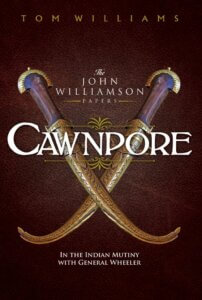

A story featuring ‘our oldest ally’
Since I visited Portugal to research for Burke and the Lines of Torres Vedras, I’ve been a fan of the country and its long relationship with England. I’ve been quite irritated in the last few weeks to keep hearing that America is “our oldest ally”. Whether you think America is an unreliable partner or a valued friend, it’s simply not true that it’s our oldest ally. The Anglo-Portuguese Alliance was established by the Treaty of Windsor in 1386 and is the oldest alliance that is still in force by political bilateral agreement. In 2022, Britain and Portugal signed the UK-Portugal Joint Declaration on Bilateral Cooperation, thereby reinforcing the Anglo-Portuguese Alliance and confirming its status.

Lisbon
I took to social media last week to point this out. Most of my social media posts vanish without trace, but some people noticed this one and were even kind enough to express an interest in a book set in the context of the Anglo-Portuguese alliance.
As with most of my stories about James Burke, my hero’s adventures are entirely fictional, but the background is historically accurate. Burke is in Lisbon, hunting down French agents who might reveal the secret of the Lines of Torres Vedras. The lines were a series of interlinked forts and gun positions designed to stop any French advance on Lisbon. As one of the people who commented on my post said, “Those Lines, completely astounded and defeated the French in their invasion of Portugal.” The French, who had expected to capture Lisbon and spend the winter feeding off the allies’ food supplies, found themselves stuck in countryside which Wellington had turned into a desert. The British had conducted a ruthless scorched earth policy north of the lines, which was devastating for the French who relied on living off the land. With no food or shelter, French losses were considerable. Not only were the British able to spend the winter in comparative comfort, but Wellington’s scheme substantially reduced the effectiveness of French forces in the Peninsula without the tedious business of engaging them in battle. (Wellington was careful to avoid set-piece battles in the Peninsula unless he was very confident of winning.)
The plan would only work if the French were unaware of the existence of the Lines. If they knew that they faced an impregnable obstacle, they would retreat to Spain and spend the colder months in winter quarters.
The Lines extend over 30 miles from the Tagus to the Atlantic and by 1812 incorporated 152 redoubts armed with 534 guns. Yet the secret of the Lines was kept until the French fell into the trap.

We know that the French had spies active in Lisbon. At the very end of 1810 four spies fled Lisbon to join the French. This was the historical peg on which Burke’s adventures were hung.
You could not disguise the fact that so many forts were being built. The secret was kept because Colonel Fletcher (pictured), the engineer responsible for their construction, managed to conceal the way in which the forts fitted together, alongside changes to the landscape where roads were blocked, bridges were demolished, and rivers were widened. The result was impregnable. They certainly came as an unexpected shock to the French commander, Masséna when he first encountered them in October 1810. ‘Que diable,’ is supposed to have been his immediate response.

Colonel Fletcher features in the story, as does the British general, Beresford. Readers who have been following Burke since his first adventure, Burke in the Land of Silver, may remember him as the British commander in Buenos Aires.
I can strongly recommend a visit to the remains of the Lines, which have held up surprisingly well for over 200 years. You can read about them and see my own photographs on my blog HERE and HERE.
Burke and the Lines of Torres Vedras is available on Kindle at just £3.99 and in paperback.

Tis the Season to Buy More Books
They say that if you want to make God laugh, you should tell him your plans. I had some vague plans about using November blog posts to try to sell the odd book. Even with my attempts to cut back on blogging, I still post something almost every week and most of them are remarkably unconnected to the business of getting you to buy the stuff I write. So November should be nose-to-tail selling posts. Then I suddenly got my spot on the NHS waiting list to get a new elbow (details HERE if you’re interested) and my selling blogs skidded to an unscheduled stop.
So here we are in December and I hope that I still have time to encourage you to buy a friend one of my Galbraith & Pole books for Christmas.

Galbraith & Pole is my foray into Urban Fantasy. I didn’t even know what urban fantasy was until I started to write it. Apparently it’s fantasy stories (in my case featuring vampires, werewolves, and mad scientists doing exciting things with genetic modification) which are set in a realistic contemporary environment. If you’ve read Rivers of London, that’s the sort of thing I mean. (And if you haven’t, can I suggest that you should?)
I’ve written three Galbraith and Pole stories so far and I hope to write more. They are an awful lot less work than historical fiction (he said with feeling after nine months stuck in the world of 1812). I really enjoy doing them but, sadly, with only three they don’t have the visibility of the James Burke series. People who have discovered them seem to like them. Here are some comments on Amazon:
- A cleverly-conceived, well-written and excellently plotted novel about murder, policing, vampires, and Tango… fresh, original, and hugely entertaining.
- This is a fast paced good read … I shall never look at Brompton Cemetery in quite the same way again!
- If a book can be too engaging and unputdownable, then this one is a great example of such a novel.
- Fun and fast to read, with just the right amount of black in its comedy.
All three are available in paperback at £6.99. They make excellent Christmas gifts.


British India to 1857: The Rise and Fall of the East India Company
If you follow me on Twitter or read last week’s blog post, you’ll know I’m just back from a holiday in India. I’d like to blog about India while the country is still top of my mind. Last week I did touch on how the war of 1857 (the Indian Mutiny or the First War of Independence depending on when and where you learned about it) still affects the way Indians view their history and their relationship with Britain, although not as much as you might expect. I thought that this week I’d take a look at the events that led up to the War of 1857. I’ve covered this before and my post about it remains one of the most widely read I’ve ever done, so it seems worth repeating for an audience that might not have been following me back when I wrote it.
#############################
In the mid-19th century, India, the jewel in Britain’s imperial crown wasn’t, technically, part of the Empire at all. It was run by the East India Company, a commercial organisation, originally set up to trade with the Far East. Under the India Act of 1784, the activities of the Company were subject to direction from the British government, but the Company remained a commercial organisation with shareholders who were paid dividends from the Company’s substantial profits. How had we reached a situation where one of the world’s largest countries was being administered for profit by a private company?
For centuries, Europe had traded with the Far East. The spice trade was of vital economic importance as far back as the days of Ancient Rome. Look in your store cupboard, even today, and see how many of the spices we use come from the Far East. And remember that, in the days before refrigeration, spices were essential in making meat palatable.
Until the 15th century, trade routes to the East went overland and were controlled first by Arabs and later by the Ottoman Turks. It was not until 1498 that the Portuguese explorer, Vasco da Gama, navigated round the Cape of Good Hope and opened a sea route from Europe to the Far East. This meant that European merchants could trade directly with their suppliers and a new age of maritime commerce was born.
Britain was late to the party. By the time that the Queen Elizabeth signed the original Royal Charter of the East India Company in 1600, the Portuguese and the Dutch were well established in the Far East. Repeatedly rebuffed by their rivals in the East Indies, Britain looked to the possibilities of India.
It was not until 1639 that the Company established its first permanent base in India, in Madras on the Bay of Bengal. In 1668, it acquired Bombay, and then Calcutta followed in 1690. These three “factories”, as they were known, were intended as trading outposts: places where merchants could warehouse goods imported and exported in the increasingly profitable trade between Britain and the Indian states.
By the 1740s, the main threat in India came not from the Portuguese or the Dutch, but from the French. Their principal trading point was at Pondicherry, less than 100 miles from Madras. In 1749, the local ruler died. There were two rival claimants for his throne. The French and the British, both trying to extend their own influence, each backed one of the rivals. Both trading companies had their own military forces to defend their activities and each supported their own choice for ruler with troops. Open war was underway by 1750.
Although the dispute was notionally between two Indian princes, involvement of French and British trading companies led, inexorably, to the involvement of the French and British governments. Both sides sent professional government troops to support their own trading companies.
Backed by the military and naval resources of Britain and France, the two companies had now become significant political forces in the region. At this point, in 1756, a separate war broke out a thousand miles away, where the nawab of Bengal attacked and occupied Calcutta. The military build-up around Madras meant that the British were in a position to respond decisively. Ships of the Royal Navy carried an army from Madras to Bengal. At the Battle of Plassey on 23 June 1757, Robert Clive, commanding the forces of the East India Company decisively defeated the Nawab of Bengal, supported by French troops. The defeat of the Nawab was of huge symbolic importance and Plassey came to be seen as marking the start of British rule in India.

Statue of Clive of India. Whitehall, London
Immediately following the victory at Plassey, Clive installed the British candidate, Mir Jafar, as Nawab of Bengal, Orissa and Bihar. Effectively, the East India Company now governed Bengal through a puppet ruler.
The tax revenues of these provinces now passed to the Company with Mir Jafar left responsible for justice and policing. (The Company took over even these residual powers in 1772.) All Frenchmen were expelled from Bengal. With the revenue from Bengal, the company was able to expand its efforts against the French further south and their hold over Pondicherry was destroyed in 1761.
India, at this time, was not a single country. The place was governed by local rulers, some with limited authority while some were absolute monarchs of huge areas of the subcontinent. All, though, recognised that the political and military presence of the British had changed the balance of power for ever. Some chose to make formal alliances with the British. Others sought to maintain some kind of independence by joining with the French.
The Sultan of Mysore allied with them to war on the Company in southern India in the late 1770s and 80s. His son, Tipu, became the most powerful threat to British hegemony. He styled himself the “Tiger of Mysore” with tiger motifs worked into his uniforms, cannons, cane handles, bed hangings, swords and thrones. His famous model of a full size tiger killing an East India Company soldier is now on display in London’s Victoria & Albert Museum.

Tipu Sultan sent agents to Europe to buy arms that might enable him to meet the British on equal terms. Intelligence reports suggested he bought 50 cannon, 80 gun carriages, and 100,000 cannonballs, besides muskets and sabres. His army was built up to the point where he did pose a real threat to the British, but he was ultimately defeated, dying in battle in 1799.
By now, the Company was committed to Indian politics. Company troops had to defend the borders of those rulers that the Company had put in power and this meant coming to terms with their neighbours. In some cases “coming to terms” meant crushing militarily. In others, alliances were formed. The continuing involvement of the French, trying to regain territories that they had lost, and carrying on their Revolutionary Wars in the Indian theatre, meant that the Company continually felt under threat. Rulers who had not been won over to the British side might always ally with the French. Every new territorial gain, therefore, meant more territory that had to be defended, which, in turn, meant the need for further expansion.
The British conquest of India, state by state, was far from being motivated solely by the need for self-defence. The settlement after Plassey, gave the East India Company vast tax revenues. Clive predicted a £2 million annual revenue surplus (an incredible sum in 1760), which led to a 100% rise in the price of Company stock.
The military also benefited directly from the campaigns that accompanied the Company’s expansion. The word “loot” comes from the Hindu word for booty and its adoption into the English language gives an indication of the enthusiasm with which European troops plundered their enemies. Everyone from the humblest private to the general could expect to get rich should they survive a war in India.
As the Company moved from a commercial to a political entity, trade became an increasingly unimportant part of its activities. In 1833 the Charter Act ended the Company’s trading rights in India, as trading was deemed to be incompatible with ruling. The East India Company was therefore the ultimate example of privatisation. The entire government of one of the largest countries in the world had been outsourced to a private supplier whose profits came from the tax surplus of the nation that they governed. (Thomas Babington Macaulay, a leading British politician who served on the Supreme Council of India, described it as “the strangest of all governments … designed for the strangest of all empires”.)
Government for profit clearly had a vast potential for abuse. A clear example of this came early in the East India Company’s rule, with the Bengal Famine of 1770. This is estimated to have killed around 10 million people – about a quarter of the population of the province. During this time, the government of the East India Company took no effective measures to reduce starvation but, instead, increased land taxes and encouraged the growing of non-food crops (including opium) instead of the desperately needed rice.
Despite horrors such as the famine, many aspects of British rule were benign. In a time when communications with India were slow, British administrators would spend years in post, often not returning to Britain for long periods. In general, the late 18th century saw a relaxed coexistence between the Company’s servants and the native rulers. Many pleasures were shared, with British officers often enjoying lavish hospitality from native rulers.
Initially too, intermarriage was encouraged, with the Company giving cash gifts when their employees had children with Indian women, on the basis that the children would grow up to soldier for the Company. Colonel James Skinner, the founder of a famous cavalry troop, Skinner’s Horse, fathered a substantial Anglo-Indian dynasty. According to his family he had seven wives, while legend claims he had fourteen. In appropriately multi-denominational style, Skinner built a mosque for one Muslim wife, a temple for a Hindu one and then his own church in Delhi, where he was buried in 1841.
The result of such good relationships was a European ruling class that, for a while at least, demonstrated some understanding of India and a real interest in improving the economy of the country. The commitment of enlightened European rulers to their Indian subjects was rewarded with a surprising degree of loyalty and respect by many of the Indians.
By the mid-19th century, though, such mutual respect and understanding was breaking down. One in three wills made by Company servants between 1780 and 1785 made provision for Indian wives or mistresses. Between 1805 and 1810, it was down to one in four and by the middle of the century, such provisions had almost entirely disappeared. A new breed of administrators was ruling India, often contemptuous of all things native. Christian missionaries, whose activities had been restricted by the Company until 1833, were now proselytising widely in a country which was not naturally inclined to Christianity. Changes in the structure of the Army had reduced the pay and promotion opportunities of native soldiers. Perhaps most seriously, the British now controlled so much of India that they were increasingly ruthless in their manipulation of the law in order to seize those few states that remained even notionally independent.
By the time of my novel, Cawnpore, British rule had lasted almost 100 years. A trading company, still structured as a commercial organisation, was ruling over around 200 million people. It was a time of technological and social change, yet the administration was increasingly out of touch with the people and the army was restless. The scene was set for revolution.
In 1857 a rumour spread that the cartridges issued to native troops had been greased with pig and beef fat, making them unclean for both Moslems and Hindus. The story about the fat may well have been untrue. Despite official inquiries, no one will ever know for sure. On 24th April Colonel Carmichael-Smyth of the 3rd Light Cavalry took it on himself (against the advice of many of his officers) to insist that his men drill with the new cartridges. The men refused and 85 were convicted of mutiny. On May 9th, the men were paraded in chains before their regiment at Meerut in north west India and marched off to jail. Shamed by the treatment of their comrades, the regiment rose in revolt on Sunday 10th May, 1857. The Indian Mutiny had begun.
What started as a mutiny in one small outpost became a revolt that swept across the sub-continent and nearly saw Britain driven from its most important colonial possession. When it was over, millions had died, either in the fighting or the reprisals that followed. The East India Company was abolished soon afterwards. The British continued to rule for almost another hundred years, but the relationship between rulers and ruled had changed forever.
Cawnpore

My book, Cawnpore, is set around the siege of Cawnpore, which was a particularly terrible incident in a particularly horrible war. It’s my personal favourite of all the books I’ve written. It’s the second of my books to feature John Williamson, but it’s completely self-contained, so you don’t have to read The White Rajah first. It’s available as an e-book or in paperback.
Cawnpore has not got anything like the sales of my James Burke books, which I think is a pity because people have said some very nice things about it:
“For anyone who has a love for this period, Cawnpore is probably one for you.” Historical Novel Society
“All that historical fiction should be: absorbing, believable and educational.” – Terry Tyler in Terry Tyler Book Reviews
The Kindle edition is an absurdly inexpensive £3.99. Please buy it.
The photo at the top of this post shows part of the royal palace within Delhi’s Red Fort.

Why I don’t say I’m a historian
Over on Twitter people are reviving the old Academic Historians vs Historical Novelists debate. I’d been vaguely thinking about writing something about this and had just decided not to when this discussion got me thinking about it again.

I’m not going to get into the whole argument about whether academic historians are stuffy or whether historical novelists dumb down their subject matter. There are obviously academic historians who can completely kill the subject and historical novelists who aren’t safe outside of the 21st century, but many academic historians write fascinating and lively accounts of their periods and many historical novelists are almost obsessive in their grasp of the detail of what they’re writing about. In the former category, I can give Jacqueline Reiter as an example. She’s engaging and her biography of Lord Chatham reads like a novel. I’m waiting desperately for her biography of Popham, which is bound to be a brilliant piece of historical research but which people who know her can reasonably expect will also be hilarious.
There are loads of historical novelists whose understanding of their periods is quite astonishing but the one I’ll pick out is Lynn Bryant. Her accounts of Napoleonic battles are spectacularly well researched and she can give many military historians a run for their money.
If many professional historians are great writers and many novelists really know their history, then what is it that distinguishes them?
I have I clear interest in this. Occasionally, it is suggested that I should set myself up as an “expert” in Napoleonic history – especially some specifics like the Battle of Waterloo. The Daily Mirror actually quoted me as a “historian” in a feature about James Brooke from my book, The White Rajah. (That’s me highlighted at the bottom right.)

I’m very reluctant to claim to be a historian, having no qualifications beyond O-level (yes, I pre-date GCSEs) and knowing a few ‘real’ historians who are far better informed about history than I am. My main reason for not wanting to be thought of as a historian, though, is that ‘real’ history is hard.
I do know quite a lot about Waterloo and the history of the period so I did wonder if I could publish some of my notes and blog posts as a simple historical introduction. The book I had in mind started with a quick portrait of the two main protagonists: Napoleon and Wellington. This being an introduction for the casual reader, I could hardly not mention the whole business of Napoleon’s height. (Spoiler alert: he wasn’t short.) I remembered reading that the Emperor of Austria used to ensure that when Napoleon visited he was always surrounded by the Emperor’s own guards – men selected as being particularly tall. It’s a nice story and a good example of the way in which Allied propaganda sought to literally diminish Napoleon.

I remember reading it and I’m pretty sure it’s true. I’d certainly be confident in making a reference to it in a novel set in the period. But if I’m writing nonfiction, I need to put in references. And could I find any actual evidence to support my claim? No, I couldn’t. Even though I was pretty sure I could remember which book I’d read it in. Rather than let it go, I took to Twitter, where I know quite a few Napoleonic historians and several tried to help. They even asked their friends. It is, after all, a really good story and I’m probably not alone in wanting to pin it down. In the end, several historians turned their mind to this and the result was – absolutely nothing.
This was practically the first thing that I wanted to check in the whole book and it made me realise that it was going to be a major undertaking, even though I already knew, with 99% certainty, most of the things I was writing about. Like I say, real history is hard – far too hard for me. Real historians find it hard too. It’s just that they’re made of sterner stuff than me. Jacqueline Reiter, who I mentioned above, complains that she has just produced over 18 pages of bibliography for her next Popham book. That’s going to be a lot of references.
Sadly, it looks as if my nonfiction account of the Waterloo campaign will never see the light of day. I’m happy to give talks on it if anybody wants them. The picture at the top of the page shows me and Lynn Bryant (the Lynn Bryant who writes brilliant military history) talking about historical fiction in the pre-covid days when things like this happened. (If you want me to talk at one of your events, you can find out more about author talks HERE).
When it comes to writing history, though, I will spend the time and energy I save on proper note-keeping to write stories that are generally true to the historical facts but which lack references. But I’m very glad that there are professional historians around, so that I (and all the other historical novelists like me) can take their hard work and turn it into entertainment.
